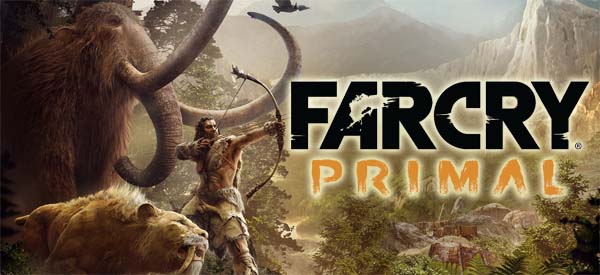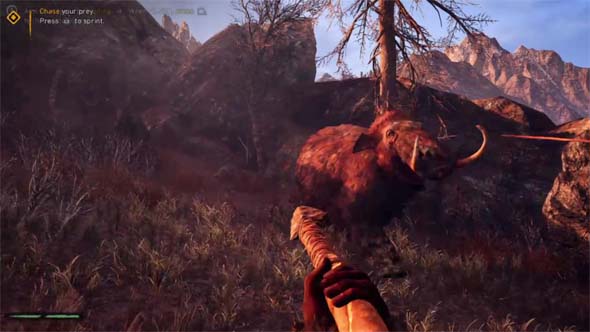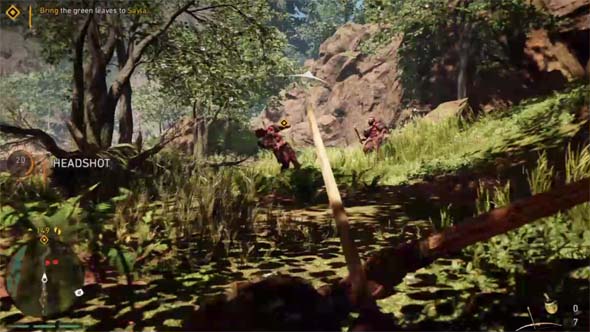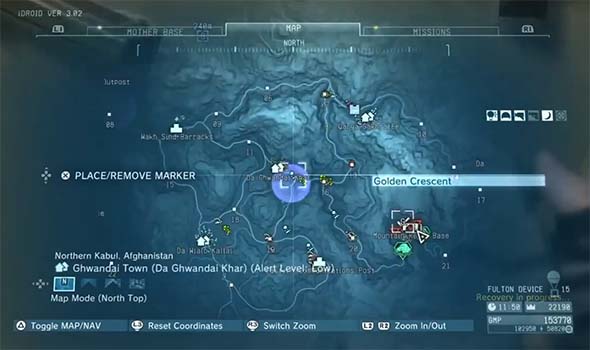
I've never played any of the Far Cry games. I possess a copy of Far Cry 4 because it came bundled for free with my PS4, but I've yet to actually insert the disc into the console and try the thing. I was intrigued by Far Cry Primal because it looked like it might explore a novel subject matter that games have kind of ignored for as long as I can remember. Apparently, Far Cry 4 had a bit in it in which you play as a primitive human riding around on animals during a drug-fueled hallucination, and Ubisoft decided to adapt that concept into a full game.
The last time that Ubisoft had done something like this, they had taken the naval combat from Assassin's Creed III (the completely dissociated highlight of an otherwise boring and stupid game) and converted it into Assassin's Creed IV: Black Flag. And I loved Black Flag! So I was optimistic that Ubisoft might have another novel treat in store for me. I've played dozens of first person shooters, but I've yet to play as a caveman in 10,000 BCE, so let's give this a go, shall we!
The game begins by showing the date 2016, with modern ambient sounds, apparently intended to make the player think that the game might have some kind of present-day framing device (similar to Assassin's Creed). But then the clock starts ticking back to 10,000 BCE, and the game begins. I wonder if this was intended to mock Assassin's Creed and subvert possible player expectations.
Stone age shooter
This game got off to kind of a rough start for me. I was killed by the mammoth in the tutorial because it charged at me before the game displayed the tutorial tip teaching how to attack with a weapon. So that seemed like a cheap death, and gave me a bad first impression. Fortunately, the next few hours of play didn't have any similarly sloppy design, and I was rather enjoying myself.

I died in the tutorial because the mammoth charged me before the game taught me how to use my weapon.
It didn't take long, however, for the novelty to wear off. Combat has a focus on melee combat with clubs and spears, which leads to a problem similar to other first-person hack-n-slash games: the constrained field of view makes situational awareness very difficult. Without the option to toggle to a third-person view, it's difficult to tell exactly what is going on immediately around your character, and close-quarters combat with mobs frequently degraded into just spinning around mashing the attack button. Fighting animals can be even worse, as many of them (such as dholes and badgers) are small and fast and incredibly difficult to actually hit. The problem is mitigated somewhat as the game goes on, as new utility abilities are introduced, but I was saddened that Ubisoft didn't really do anything particularly interesting with the basic combat.
And it doesn't really get much better when the utility abilities are introduced, as they mostly just involve simply sicking your tamed beasts on the enemies and hoping that the beast doesn't die. In the regular gameplay mode, you'll also have access to overpowered one-hit kill attacks and bombing runs with your owl that act similarly to an air strike or artillery bombardment in other games. These attacks are so overpowered that the Survival Mode disables them entirely. If you have a powerful enough wolf, bear, or saber-tooth tiger beast, you can often just get away with commanding it to charge a group of enemies while you sit back and watch.

This is one game in which a bow and arrow actually makes sense as a primary weapon. [More]
f789f1b9-8096-44f0-a9aa-91493a4c83b7|0|.0
Tags:Far Cry, Far Cry: Primal, Ubisoft, prehistory, caveman, mammoth, wolf, bear, saber-tooth tiger, owl, beast, beast master, bow and arrow, spear, club, crafting, survival, open world, Darwin Award, Achievement unlocked
I wrote a lengthy blog late last year about the stagnant, "limbo"-like feel of most open world games' narratives. I had written that blog mostly before I played Metal Gear Solid V, and so I wasn't able to incorporate my thoughts regarding that game into the blog. But I did come to a new realization about open world gaming while I was playing MGSV. In my review of that game, I noted that:
"Even the open world itself feels constrained, as sheer cliffs prevent you from travelling too far off of the roads and serve to functionally railroad the player towards the small set-piece outposts and villages."
- from my Metal Gear Solid V: the Phantom Pain review
I realized while playing MGSV that the game had built this large, open world (well, two large, open worlds really, but I hadn't gotten that far yet), but it didn't really care to let the player actually traverse that space or use it in any meaningful way other than scavenger hunting for collectibles. At least those collectibles felt relevant to gameplay though! Roughly half the map is dead space that the player can't even access. There was also this strange focus on using the helicopter to drop in and drop out of missions, rather than actually living in the game world, as the character had to do in Snake Eater. The map started to feel less and less like a place, and more like a convoluted mission-select screen. At first, this seemed like a strange, isolated example of an open world game that really doesn't want the player actually exploring its world. But as I thought about it, I realized that this isn't really a new phenomenon; it's actually just a very extreme example of what has become a sort of defacto state in most open world games.

The Afghanistan map of Metal Gear Solid V feels heavily constrained by sheer cliffs.
Think about it this way: in a linear game with rooms and corridors, every hallway and room should serve some purpose or function. In most games, this function will be some kind of skill or system mastery test. An action game like Devil May Cry will throw enemies at you to fight; a puzzle game like Portal will have a puzzle (or a piece of a puzzle) in the room to solve; a stealth game like Metal Gear Solid 3 will have a sneaking challenge or obstacle to pass; and so on. In the best games, each of these challenges will also provide a unique or novel test of skill or system mastery: unique combinations of enemies, unique puzzles, or novel arrangements of enemies and obstacles. Other games can use those rooms for thematic or narrative purposes. A survival horror game like Resident Evil or Silent Hill will usually put enemies, puzzle items, or supplies in a room, but some rooms might instead contain a scripted scare. In some cases, a room might even be left completely empty in order to build some kind of tension or anticipation, or to delay the release of already-built tension or anticipation.
So what is the gameplay purpose of an open world map? ... [More]
d6e62cdb-b171-437a-b1a7-107859c9c818|4|4.5
Tags:open world, sandbox, game design, map, paradox, traversal, travel, cartography, geography, narrative, ludonarrative, ludonarrative dissonance, quest, exploration, driving, racing, vehicle, Ubisoft, Bethesda, Beenox, Metal Gear Solid V: the Phantom Pain, Assassin's Creed, the Amazing Spider-Man, Spider-Man, web-swinging, The Elder Scrolls, Skyrim, The Witcher 3, Fallout, Mad Max, Far Cry
|

| 12 | | | | | | | 60 | | 11 | | | | | | | 55 | | 10 | | | | | | | 50 | | 09 | | | | | | | 45 | | 08 | | | | | | | 40 | | 07 | | | | | | | 35 | | 06 | | | | | | | 30 | | 05 | | | | | | | 25 | | 04 | | | | | | | 20 | | 03 | | | | | | | 15 | | 02 | | | | | | | 10 | | 01 | | | | | | | 05 |
|